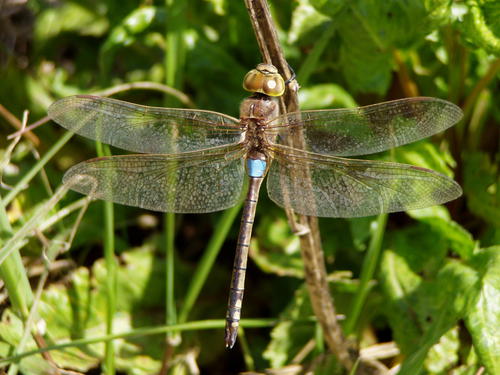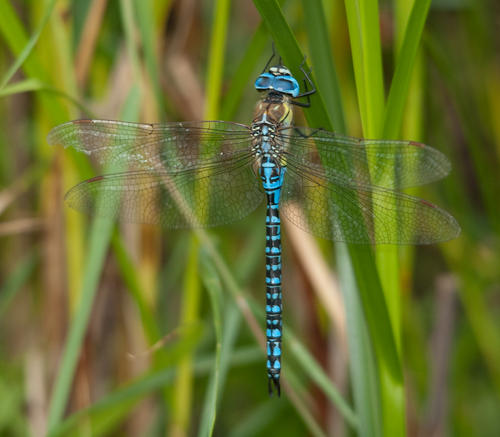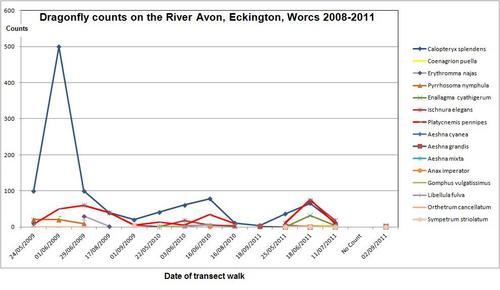2011 - The Dragonfly Year
Mike Averill
After the very cold weather at the end of 2010, the New Year brought mild weather with few cold nights and by March temperatures were well above average. This brought insect emergences forward and our first Large Red Damselflies Pyrrhosoma nymphula were seen in mid-April. The Common Club-tail dragonfly Gomphus vulgatissimus was also early to emerge being seen on the 4th May at Bewdley. The previous winter was certainly one of the coldest we have had for many years with the River Severn freezing over for the first time since 1981 and there is always the question about what effect that has on insect numbers. There may be a clue to this in that the Common Club-tail numbers emerging this year were the lowest in four years.
By mid April, unbeknown to us, many dragonflies had gathered in Africa and had moved ready to fly in to the UK should good weather prevail. So with a continuation of the above average temperatures in April, the situation was set to allow unprecedented numbers of the Vagrant Emperor Hemianax ephippiger to fly in (Fig. 1.). Prior to this there had been no records for this species in the UK since 2008. In the end more Vagrant Emperors were seen in the country in 2011 than the total seen before that. I mention all this because a medium sized hawker was seen at Croome Park on the 29th April which could have been this dragonfly, and would have been a first for the county, however there is a chance that it might have been the Hairy Dragonfly Brachytron pratense. The Hairy Dragonfly was obviously on the move at this time because one was seen at Upton Warren on the 5th May, but fortunately it was spotted by an experienced observer, as this species had only previously been recorded in Worcs twice before in 1977 & 1980. The Vagrant Emperor, being strongly migrant (it is the only species recorded in Iceland), can be seen at just about any time in the UK as they start to disperse from Africa in the autumn and an individual was actually seen in Warwickshire at the end of November this year. They can also appear very early in the year when there is little else on the wing which makes confirmation easy but as April approaches other dragonflies such as the Hairy Dragonfly start to emerge adding to the confusion. A bit like the lesser Emperor Anax parthenope, the Vagrant Emperor has the blue markings at the top of the abdomen but is slightly smaller, has brown not green eyes and a brown abdomen. Two Lesser Emperors were seen this year, one at Upton Warren and one at Pirton Pool which is again a sign of movement with these migrant species. The Small red-eyed Damselfly Erythromma viridulum which suddenly established itself at Croome Park last year was seen again in high numbers with a slight range increase to nearby ponds.
Migrant dragonflies are very much to be expected in the UK with the unseasonal warm winds associated with climate change and the latest one to keep an eye out for is the Southern Migrant Hawker Aeshna affinis (Fig. 2.) As the name suggests it is like our Migrant Hawker Aeshna mixta but most of the colour markings are sky blue. There have only been a handful of records so far and not all along the south coast as you might expect.
Next year (2012) will be the last one in the survey period for the new Dragonfly Atlas and so complete distribution maps will be available by the next flight season.
Apart from surprise visitors the year (2011) appeared to be fairly quiet and it could be said that after a good start the season was soon over with lower numbers showing. These sort of impressions can be very subjective without real counts being made and it is with this need in mind that transects are being used now. Rather like the butterfly walks these are specifically aimed at dragonflies and attempt to quantify dragonfly counts in a 100 metre section, at a site, year by year. In Worcestershire a survey has been running at Eckington for three years and now there further sites at Smite and new ones at Feckenham and Croome Park.
The results of the Eckington transect is attached and in the graph (fig. 3.). 15 species were recorded over the three years of which only the Banded Demoiselle Calopteryx splendens and White legged Damselfly Platycnemis pennipes have sufficient numbers to effectively follow trends. A count is the total number of adults seen along a measured 100 metre section, as a walk past, imagining that you observe along a five metre tunnel. It appears the Banded Demoiselle had a very good year in 2009 but in 2010 and 2011 numbers were lower. The other noticeable trend was how short the season was in 2011 for all species with counts already trailing off in July. Only the White legged Damselfly and Common Damselfly Enallagma cyathigerum had a slightly higher peak count in 2011.
Images
Fig. 1. Vagrant Emperor Hemianax ephippiger. Mike Averill
Fig. 2. Southern Migrant Hawker Aeshna affinis. Neil Phillips
Fig. 3. Dragonfly counts River Avon Eckington 2008-11. Mike Averill


